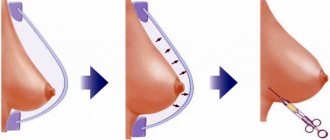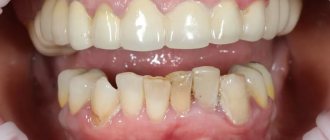Surgery to increase breast size or change its shape and volume is one of the most popular in plastic surgery. However, the intervention must be carried out by an experienced surgeon who, together with the patient, will select the most optimal size and shape, as well as the type of breast implants.
But many patients, deciding on surgical intervention, do not know that breast plastic surgery with the placement of implants is carried out for a certain period of time, since over time there may be a need for repeated intervention, including replacement of implants.
The scary phrase “capsular contracture.” Do I need to remove the implant?
— Any implant, no matter what safe materials it is made from, is a foreign body for the body. And this is a normal protective reaction of the body when a capsule forms around a foreign material. If the capsule formed around the implant is thin and elastic and does not deform the tissue, then this is considered the postoperative norm. If, even after the end of the postoperative period, the breast tissue is painful, hardened, or asymmetry or deformation has appeared over the years, then such a pathological process, called capsular contracture , requires treatment.
Often we are talking about repeat surgery. The reasons for the formation of denser capsular contracture are different: it is impossible to predict in advance what kind of capsule will form around the implant. Today, medical technologies are developing rapidly, and implantation is practiced in various industries. These include plastic and reconstructive medicine (breast, nose, chin implants), cardiac surgery (stents, vascular prostheses, artificial heart valves), orthopedics (artificial joints, intervertebral discs, vertebrae, metal structures), and dentistry (dental implants). Important: the formation of a fibrous capsule is not only a problem with breast implants. This is a problem of interaction between the body and a foreign body, and is typical for absolutely any implant.
Of course, when there is a problem, you need to think about how to solve it. But when there is a high-quality implant, when there are no objective reasons for treatment or removal of the implant, then there is no point in succumbing to general hysteria. The fact is that modern implants are quite inert and the risk of such complications is minimized.
What materials are breast implants made from?
When talking about what types of breast implants there are, they are most often divided according to the material of production. It is this that influences such qualities of products as elasticity, naturalistic appearance, the ability to maintain or restore shape during movement, and most importantly, safety and survival rate.
Today we can say with confidence that saline implants based on saline solution have long been left behind and the era of gels has arrived in mammoplasty. Moreover, many experienced manufacturing companies use their own developments and patented gels produced based on the results of laboratory research. However, in most cases, silicone-based gel formulations are used as fillers.
Based on the material used, the following types of breast implants can be named:
- Silicone is the most common and popular type. Silicone has a high density, soft elastic structure and is absolutely harmless. Silicone implants take the natural shape of the breast and are visually indistinguishable from it.
- Filled with cohesive gel. Cohesive gel is a type of silicone, it is very soft and has a jelly-like structure. This guarantees a natural look and feel; breasts with such implants are almost impossible to distinguish from natural ones, even tactilely.
- With highly cohesive gel. This is also a subtype of silicone filler, but more dense and elastic. Remembers the shape and does not deform.
- With Soft Touch filling - this material is similar to highly cohesive gels, but softer, due to which it imitates breast tissue to the touch and imitates their behavior during movements.
- Hydrogel - hydrogel or carboxymethylcellulose - is a natural polymer that is fully compatible with the natural tissues of the human body. It provides implants with a natural shape and elasticity; if the shell is damaged and leaks into the body, the material breaks down into water, glucose and carbon dioxide, and is excreted naturally. Products with such filling are often called bioimplants.
- Silica gel – endoprostheses filled with microscopic silicone beads. They are lightweight, naturalistic, and comfortable to use. The best option for large-sized implants - due to its lighter weight, the prosthesis does not pull on the skin, does not provoke discomfort, sagging breasts or stretch marks on the skin.
It is worth noting that all gels have a viscous, elastic, non-liquid structure. Therefore, if the implant shell is damaged, they do not leak or leak into the body tissues, but remain in place. This guarantees the absence of complications, deformation, pain or discomfort in the patient’s chest.
*Photos before and after breast augmentation with Motiva implants (medium profile)
Optimal medical and consumer characteristics are demonstrated by models made of highly cohesive gel. As an example, let's look at the Motiva implants, which are consistently included in the ratings of the best breast endoprostheses.
They are filled with Progressive Gel Ultima and Progressive Gel Plus gels. Both materials are the company’s own development, have undergone clinical studies and meet international safety standards.
The gel is completely biocompatible, does not provoke complications, and due to its dense structure and the presence of an additional protective layer of Bluseal, its leakage and contact with breast tissue is completely excluded.
Thanks to the structure and composition of the gel, implants retain their shape in all positions of the body.
How often does a seroma form after surgery and is it necessary to remove the implants?
— Seroma is an abnormal accumulation of serous fluid, sometimes developing after plastic surgery. It is considered a rare complication of mammoplasty. Seroma usually resolves on its own within a few weeks. Safe implants provide minimal risk of such a complication. Another problem that is often discussed in the media is anaplastic large cell lymphoma (BIA-ALCL). The formation of lymphoma is also influenced by various factors - both health status and what implants the clinic uses.
Doctors do not deny that seromas and lymphomas are possible. In my practice, only once was there a suspicion that the patient, due to the nature of her complaints, might have a complication in the form of lymphoma. After removing the implants, we did a histochemical examination. But the presence of ALCL was not confirmed! Here you need to think more about the quality of the implants installed and how skillfully the operation was performed. Lifestyle is important, because problems can provoke other diseases of the body.
How does service life differ from warranty?
The service life is usually longer than the warranty period or the same as it. Even if the warranty period ends, the clinic is still responsible, but only for significant deficiencies, the occurrence of which is proven by examination to be its fault.
- The service life of an implant is the period during which it does not lose its performance qualities and can be suitable for use without harm to health.
- A guarantee is an obligation of a manufacturer or a clinic for a period during which replacement of a design or elimination of deficiencies in the service provided is carried out free of charge if the occurrence of a warranty case is confirmed by an expert examination.
If breast implants were placed 10-15 years ago, do they need to be replaced?
— Everything is very individual. It cannot be said that implants from one manufacturer last a lifetime and not from another. Doctors cannot predict how the implant will behave years from now. I repeat: the interaction with the implant is influenced by many factors - immune status, hormonal levels, age, and health status change.
I want to encourage our future, current and former patients not to be subject to the hysteria about implants and their removal. When there is a rupture, capsular contracture, or suspicion of some infectious or oncological diseases, then, of course, you need to check both your health and the implants. But this does not mean that you need to run and delete everything at once! After all, this is followed by the next stage - what will happen to the breast next?
What is EN-BLOC operation? Is the implant always removed along with the capsule?
— Implants are always removed as one block along with the capsule. That is, the implant and the entire complex of tissues that give rise to the pathological process - contracture or rupture of the implant. Then, outside the body, visual (the capsule is cut, the integrity of the implant and its contents are checked) and histological examination. This technique for removing a pathological block, called EN-BLOC or capsuloectomy , has been used for a very long time. This method is nothing new for medical professionals. Now “enblock” is just a beautiful term that has appeared in everyday life. We at the LIPEX clinic have been performing such operations for a long time.
Is it possible to remove old implants and immediately install new, more modern ones?
- Yes, sure. If there is no pathological process and there are no contraindications, then you can immediately undergo breast enlargement surgery and improve shape using other implants - more modern ones, with a higher degree of guarantee. At the same time, you can tighten or reduce the amount of tissue. That is, after removal of the pathological process, the patient has access to all types of surgical interventions on the mammary gland.
There are, but extremely rare, situations when this is impossible. Most often this is due to infection or when there is a risk of the cancer spreading. Then the treatment stage is carried out first, and only then everything else.
Other reasons for secondary surgery
There are many other reasons why it is necessary to remove the old implant and install a new one:
- inflammation or infection. These phenomena can be provoked within a month after the operation, so the woman needs to keep in touch with the doctor and, if necessary, visit him for an examination;
- The implants installed two decades ago are made of other materials: heavier, less durable, the imperfect shell of which requires replacement;
- physiological changes in the body. As a woman ages, her body undergoes natural changes and breast correction may be required. Some women decide to improve their breasts with age: change their shape or size, as well as their location;
- change in symmetry after lactation. Breasts may become asymmetrical over time. This is a common situation during pregnancy and breastfeeding. Slight asymmetry of the female mammary glands is normal and in most cases does not require surgical intervention or correction.
How quickly does a woman’s body recover after implant removal?
—Usually the operation is performed under general combined anesthesia. Removing or replacing breast implants is a simpler operation than breast augmentation, since the “bed” for the implants is already formed. The operation lasts 1-2 hours. Everything is removed, as I already said, in one block, so the healing process goes quite quickly. It is necessary to wear corrective compression garments, come for dressings and check-ups with your doctor. In the first days after the operation, you should not travel by plane - this should be considered by those who plan to arrive for the operation from other countries.
Patients spend 1-3 days in the hospital, depending on their condition. All the nuances - additional manipulations, what incisions and shape of the breast will be, possible risks and recommendations are discussed during a personal consultation in the doctor’s office.
In the early postoperative period, you should not play sports. If the implant is installed a second time, the rehabilitation period will differ. If under the muscle, then the restrictions for playing sports will be longer, if under the fascia of the pectoralis major muscle, then the rehabilitation period will be shorter. You can completely forget about breast surgery, if there was a primary installation of implants under the muscle, you can do it in three months, with a secondary one – up to six months: it all depends on the condition of the muscles and on the manipulations that are performed.
You can tighten your breasts without enlarging them
The most common patients of plastic surgeons are women who have lost their attractive breast shape after pregnancy, sudden weight loss and other factors. You can restore elasticity, attractiveness, and eliminate sagging without installing implants. To do this, it is necessary to perform a breast lift. Breast lift surgery is less traumatic, cheaper and safer. But it is indicated only for those patients who have a sufficient volume of their own breast tissue.
I don’t want to remove implants: how often should I check my health?
— The presence of implants, if there are no pathological processes or health complaints, is not a reason for additional checks. Just like other women, owners of breast implants should visit a gynecologist at least once a year, undergo the suggested checks and screenings, and have an annual breast ultrasonography. The doctor may prescribe additional tests - mammography, computed tomography, biopsy, checking tumor markers. All women should monitor their health, regardless of whether mammoplasty was performed or not.
Lifetime guarantee for implantation at the Doctor Levin center
Typically, when undergoing implantation, the patient is faced with two types of guarantee:
- Manufacturer's warranty is determined by the quality of the material and the durability of the design. Applies only to the integrity of the implant.
- Clinic guarantee The obligations apply to the operation itself, usually not exceeding 2 years.
Since 2003, the Doctor Levin Center for Private Dentistry, together with Nobel Biocare, has provided a unique double lifetime guarantee in the Dr Levin LifeTime Warranty format . For the implant itself - from the manufacturer, for implantological treatment - from the clinic.
We work for
the perfect result !
The use of the best Nobel Biocare implants, the involvement of highly qualified specialists, the prevention of possible risks at each stage, strict adherence to the surgical protocol, scheduled annual medical examinations - all this allows us to guarantee the indefinite service life of implantation systems.
Levin Dmitry Valerievich Chief physician and founder of the Doctor Levin center










